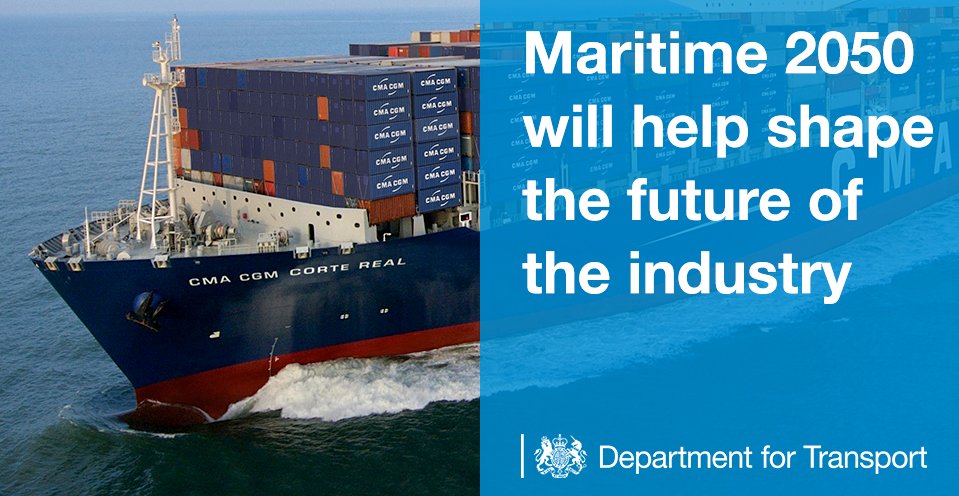

Chris
Grayling and Nus Ghani
<<<< SECTION 3 - ECONOMICS
SECTION 4 - INFRASTRUCTURE
Infrastructure for Zero Emission Shipping - Commitment In conjunction with a working group as part
of the Clean Maritime Council, Government will undertake a study to identify and support
potential UK zero emission shipping clusters.
Rationale
96. The Government’s Maritime 2050 Strategy contained the following commitments:
● Government will work to better
understand the capacity of the UK’s energy networks to support an increase
in demand for green energy from our ports and shipping sectors. It will also
consider the role the maritime and offshore renewables sectors can play in
decentralised energy generation.
● Government will review the environmental
and economic case for coastal shipping, and whether the government should play
a greater role in encouraging modal shift.
97. In line with the commitments in the Clean Air Strategy, the Government will also
publish guidelines to advise ports on how to develop effective and targeted Air Quality
Strategies.
98. The Government has also commissioned a report on Coastal Shipping and Inland Waterway Transport, to better understand the barriers, challenges and market opportunities
of coastal shipping and inland waterways within the current freight landscape. The report will model different scenarios for freight transport in 2050. Dependent on the outcome of this report, and the Call for Evidence on domestic vessels in UK
waters, further research may be necessary
to determine the potential emissions savings from short sea shipping if alternative low or
zero emission fuels are in use.
99. The Clean Maritime Council identified the issue of integration between maritime
energy demand and supply as a significant barrier to zero emissions shipping. The
Council formed the Energy Systems Integration task and finish group bringing
together representatives from outside the Council to consider the subject.
Discussions focussed on the emerging demand scenarios for alternative fuelling in
the Maritime sector. It is expected that there is merit in further discussions at a national
level on the possible pathways to zero emissions, and the necessary infrastructure
to implement them. Government will therefore undertake a study to identify and
support the development of zero emission shipping clusters.
Background - Bunkering of alternative fuels
100. Figure 6 illustrates how landside infrastructure could operate in a future
scenario where vessels operate using zero emissions fuels.
101. The Clean Maritime Council Task and Finish Group on Energy Systems Integration
highlighted the need to consider the challenge of providing infrastructure for
alternative fuel transportation and bunkering around the UK. There are a number of
challenges to bunkering alternative fuels that need to be addressed. Broadly these
fall into three main categories.
● Regulatory: the need for the
development of, and compliance with, new safety regulations for storage of alternative fuels. In
addition, there may be issues associated with planning permission for new bunkering
infrastructure.
● Investment: as the upfront capital cost
of providing infrastructure associated with alternative fuels may be substantial
for an individual port
● Market: a need to co-ordinate across
the sector to give ports greater certainty that the ships using its infrastructure will
be compatible.
102. Not all these challenges are unique to the maritime sector. Similar challenges will be
faced across other transport modes and other economic sectors as the UK moves
towards zero emissions. The Government’s forthcoming Energy White Paper, due
later this year, will take account of such challenges across economic sectors.
The investment challenges must also be considered in future work considering
economic incentives for the sector (see ‘Economics’ above).
103. A systems approach to the development of alternative shipping fuel bunkering –
whereby maritime needs are integrated within a wider, cross-economy picture of
alternative fuelling demand and supply – may help reduce costs and maximise
opportunities by aligning signals for investment across various market actors.
104. With this multi-sector approach, it will be possible to identify regional and UK wide
areas of specific advantage. There are already projects working on this basis – for
instance the case study below outlines the potential for hydrogen production from wind
power, and the specific regional advantage this poses to areas of the UK.
105. To assist in the development of a systems approach to the development of alternative
fuel bunkering in the UK, the Government in conjunction with the Clean Maritime Council
will undertake a study on zero emission shipping clusters. This study will
include a detailed assessment of the infrastructure required to enable the uptake of
alternative fuelled vessels. This will include consideration of the refuelling requirements
of vessels, as well as whether there are particular geographic locations suitable for
the production, storage and distribution of alternative fuels for shipping including
any dependencies or synergies with other economic sectors such as heating or other
transport modes. The study will consider the issues of sustainability of alternative
fuel production, noting where clusters have particular advantages in producing
fuels with the greatest emission reduction potential (e.g. CCUS opportunities and
renewable energy availability). It will also take into account opportunities as well
as safety and cost challenges related to, integration with the wider energy system
and work ongoing to decarbonise the wider freight system (e.g. with regards to
HGV
and rail).
106. Table 2 below, for instance, sets out interesting potential hotspots in the UK for
clean maritime fuel generation, storage or distribution. It is by no means exhaustive, and
many other locations in the UK are expected to have relevant clusters of experience,
demand and supply advantages.
107. The Clean Maritime Council will establish
a working group to help guide this study, which will be fed into national strategic
cross-Government work, for instance, related to the Energy White Paper
Electrification
108. Electrification in the maritime sector may
take the form of:
● Shore-side power (powering vessels’
auxiliary systems for vessels at berth, also referred to as cold-ironing)
● Hybrid electric vessels (the use of electric
motors & batteries to complement other energy sources such as diesel engines)
● Fully electric vessels (the use of
electric
motors & batteries)
●
Electric charging for port operations (e.g. powering non-road mobile machinery
such as cranes).
109. Research commissioned by the Government estimates that alternative fuels
will play the most significant role in reducing emissions from UK shipping, with electric
propulsion playing a smaller role relatively [77]. In particular, this research suggests that
electric propulsion options may be focused predominantly on smaller vessels that
operate on shorter routes, such as ferry crossings. However, these conclusions are
sensitive to several assumptions about, for instance, the capital costs of
batteries.
110. Despite alternative fuels being expected to play a more significant role, research
commissioned by the Government estimates that UK ports are still likely to see total electricity demand increase
significantly by 2050 [78]. Without any further policy intervention, this research estimates
that the total annual electricity demand at UK ports could rise from 20 GWh in 2016
to around 250 GWh by around 2050, largely driven by the demand for shore-power from container vessels. In contrast,
under a scenario in which there are very ambitious assumptions about maritime
electrification, this research estimates that annual electrical demand at
UK major ports could rise to over 4000 GWh by around 2050, predominantly be driven by demand
for electric propulsion, but with demand for shore-side power also expected to increase
significantly.
111. This research explains that a significant increase in electricity demand in ports
would require ports to invest in charging infrastructure and potentially to apply for
increased capacity from the electricity network. The scale of connection
required to a port will be influenced by the forecasted peak load (maximum energy
demand within a certain timeframe that needs to be accommodated) [79]. For an
illustration of potential scales of peak total demand, the research estimates that
the potential peak load could range from around 9 MW for a small port to around 79
MW for a large port80.
112. As demand for electrification is expected to be driven by particular vessel types,
demand for electrical capacity in ports is not expected to be uniform across the UK’s
ports.
113. The research also explored the barriers to port electrification and identified the
following potential barriers:
● split incentives to invest and coordination failures between ports and the
shipping industry;
● imperfect information on abatement options;
● existing infrastructure and onboard technologies;
● the cost of capital; and ● regulatory constraints.
114. Consultation indicates that, in particular, constraints on existing local network
capacity may be particularly challenging.
115. Given the potential role of port electrification for zero emissions shipping, further
research on routes to overcoming these barriers will be included in the study
undertaken by Government in partnership with the Clean Maritime Council on zero
emission shipping clusters. The results of this study will be fed into national strategic
cross-Government work, for instance, related to the Energy White Paper. Public procurement, subsidy
and licensing regimes
116. The Government’s Maritime 2050 Strategy contained the following commitment:
● Government will consider how public
procurement, subsidy and licensing regimes can be used to increase the uptake of green
technologies e.g. for vessels supporting the offshore energy sectors.
117. The publicly-owned civilian fleet is very small, and is largely comprised
of highly specialised vessels. Environmental performance is a key part of the assessment criteria during fleet
replacement. Over the coming years, Government will continue to ensure that the
fleet renewal process takes into account opportunities to embed the reduction
of emissions of GHGs and air quality pollutants from new vessels.
118. Besides the publicly owned fleet, certain segments of the UK maritime fleet
may have certain characteristics which may allow for faster or more extensive
reductions in emissions. Vessels associated with the UK’s offshore energy sector
may be of particular interest. Activities supporting the offshore oil & gas sector
tend to be clustered, with a particularly strong cluster of support vessels
based out of Aberdeen.
119. The UK also has the world’s largest installed capacity of offshore
wind. The construction,
operation and decommissioning of these installations involves a substantial volume
of vessel traffic. This activity is expected to increase as, under the recent agreement
of an offshore wind sector deal, this capacity is expected to grow to 30 GW of installed
capacity by 2030. The sector itself has launched an initiative aiming to reduce
emissions from its support vessels (see case study: Offshore Wind Accelerator
Vessel Decarbonisation Programme), including consideration of electric charging
of vessels direct from offshore wind turbines.
120. The potential infrastructure development opportunities associated with geographic
aggregations of this offshore energy activity will be considered as part of the study
undertaken into zero-emission shipping clusters (see above). Synergies with the
offshore renewable energy industry will also be taken into account in this study. This
may include, for instance, consideration of novel ideas such as the future potential for
offshore synthetic-fuel generation fuelled by offshore wind generation alongside the
use of empty gas reservoirs, platforms and pipelines for distribution [81].
SECTION 5 INNOVATION
>>>>
SECTION 1 - TACKLING EMISSIONS:
14
- 50
SECTION 2 - OUR APPROACH:
51 - 58
SECTION 3 -
ECONOMICS: 59 - 95
SECTION 4 -
INFRASTRUCTURE: 96 - 120
SECTION 5
INNOVATION: 121 - 129
SECTION 6 -
REGULATION: 130 - 138
SECTION 7 - NEXT
STEPS: 139 - 140
MAP - THE 2050 PLAN RECOMMENDATIONS
GLOSSARY
END
NOTES REFERENCE LINKS

Grant
Shapps - Secretary of State for Transport 2021
The
Knowledge Transfer Network is Innovate UK’s network partner, and also provides innovation networking for other funders in line with its mission to drive UK growth.
The Department for Transport
works with
Innovate
UK, part of UK Research and Innovation Clean Maritime Plan and supports the transition to Net Zero by
2050 in line with the International
Maritime Organization's (IMO's)
targets for zero emission shipping.

LINKS
& REFERENCE
https://
Please use our
A-Z INDEX to
navigate this site



